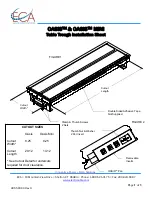
Use the worksheet
to record information about the structure,
cultural environs, and climatic conditions of the site; as well as information about the type and
length of the installation.
"Common Types of Surface Installations" below
provides
recommendations for some common installation types.
3.4 Preparing the Site for a Vault Installation
Before deploying your seismometer, you should have an understanding of the type of
installation you will use and how you will insulate your seismometer. Your installation must be
designed to provide a stable base for the seismometer without any forces or disturbances
acting on it.
The installation methods described in this section incorporate installation design guidelines
that aim to reduce the possibility of installation-related noise. Horizontal spikes in the signal
are indicative of installation-related issues, and it is normal to see horizontal spikes following
installation. However, if the spikes do not diminish after a few days, there may be a problem
with the installation. See
"Troubleshooting Your Installation" on page 49
for more
information.
3.4.1 Common Types of Surface Installations
Following are two common methods for installing and insulating a seismometer (see
and Practice of Insulation" on page 40
and
"Insulation Options" on page 42
for more
information):
Vault installation
Vault installations can be at or below the surface and usually include a pier that provides a
level platform for the seismometer to sit on and good coupling to the ground. Insulation of
the pier, vault roof, and most importantly the seismometer, is required.
The pier must be insulated from air currents to prevent tilt noise caused by the thermal
expansion or contraction of its surface. For a pier solidly connected to the ground (such as a
poured cement pad on top of bedrock), a useful technique is to place a thick quilt over the
Chapter 3 - Installing a Trillium Compact Vault Seismometer
16889R10 • 2020-11-12
Page 32
















































